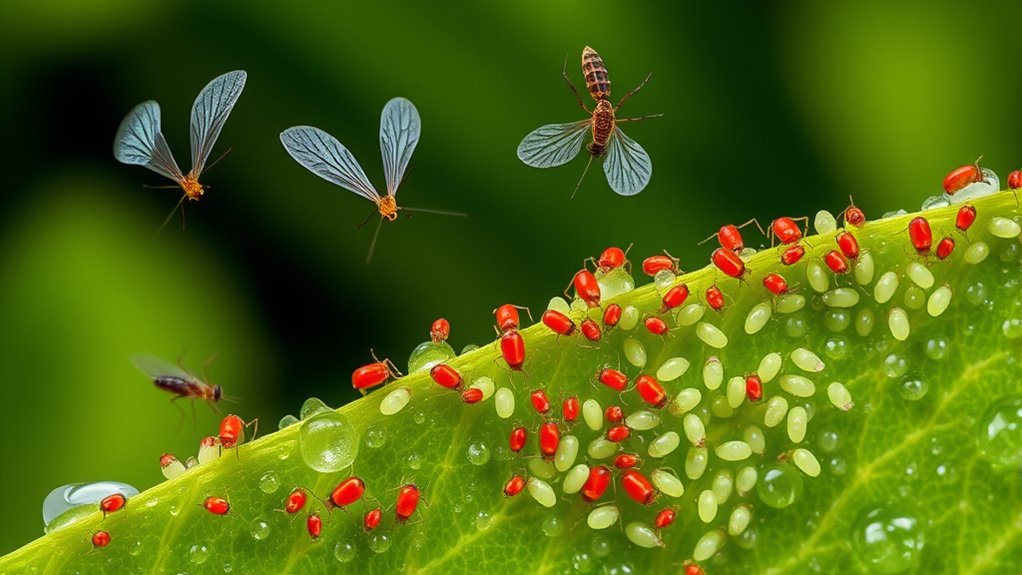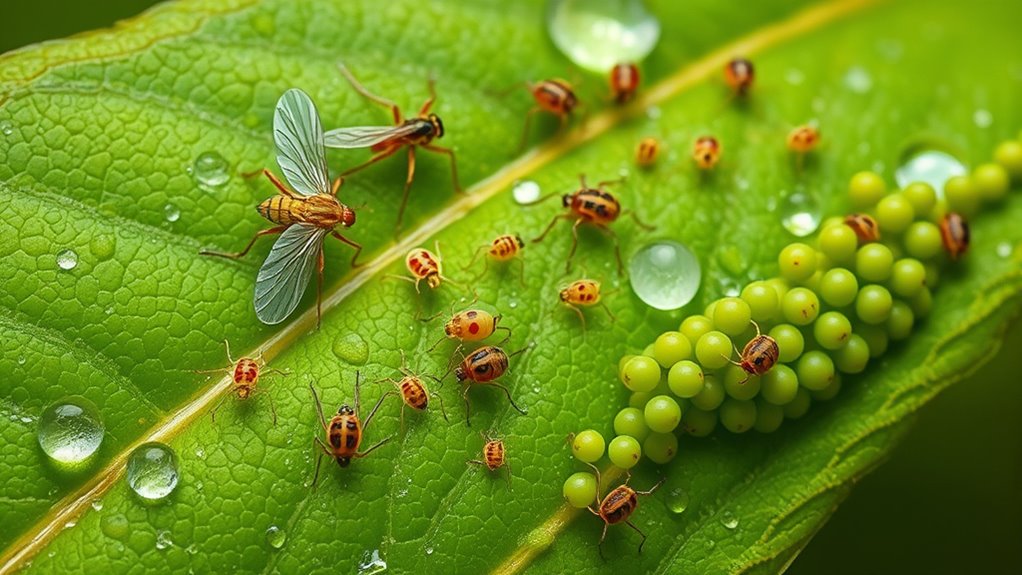To combat tiny invaders like aphids, whiteflies, and spider mites, use natural predators such as ladybugs, lacewings, and predatory mites, which are safe and eco-friendly. Remove heavily infested leaves and avoid over-fertilization to prevent worsening the problem. When necessary, apply targeted, low-toxicity treatments during early morning or late evening to protect beneficial insects. Want to discover more about effective control methods and keeping your plants healthy? Keep exploring for tips!
Key Takeaways
- Use natural predators like ladybugs, lacewings, and predatory mites to effectively reduce aphids, whiteflies, and spider mites.
- Identify specific pests early and release targeted biological controls directly onto infested plants.
- Combine biological methods with cultural practices such as removing infested leaves and avoiding over-fertilization.
- Apply chemical treatments only as a last resort, choosing targeted, low-toxicity options and applying during optimal times.
- Promoting natural predators supports sustainable pest management and protects beneficial insects and pollinators.

Tiny pests like aphids, whiteflies, and spider mites might be small, but they can cause big problems for your plants. When these tiny invaders appear, your first instinct might be to reach for chemical controls, but there are effective alternatives. Biological methods, specifically natural predators, can be a safer and environmentally friendly way to keep pest populations in check. Ladybugs, lacewings, and predatory mites are excellent natural predators that target these pests directly. Releasing ladybugs into your garden, for example, can dramatically reduce aphid numbers because they love feasting on these soft-bodied insects. Similarly, lacewings are voracious aphid eaters and can help control whiteflies and spider mites. Predatory mites, such as Phytoseiulus persimilis, are highly effective against spider mites, and they work quietly without harming your plants or the surrounding ecosystem. Incorporating biological pest control into your gardening practices can lead to a more sustainable and balanced ecosystem.
Using natural predators requires a bit of planning but offers long-term benefits. You should identify the specific pests plaguing your plants and choose the appropriate predators accordingly. For instance, if aphids are your main concern, releasing ladybugs or lacewing larvae can be a game-changer. If spider mites are the issue, predatory mites are your best bet. These biological controls are available from garden centers or online suppliers and can be introduced directly onto infected plants. Once released, they’ll seek out pests and help keep their populations under control naturally. This approach reduces your reliance on chemical controls, which can sometimes harm beneficial insects, pollinators, or the environment.
While natural predators are highly effective, they’re not always enough on their own. Combining biological control with proper cultural practices, like removing heavily infested leaves and avoiding over-fertilization, can further reduce pest problems. Chemical controls should be used as a last resort because they may kill beneficial insects and lead to resistant pest populations over time. When necessary, choose targeted, low-toxicity options to minimize collateral damage. Always read labels carefully and apply chemicals in the early morning or late evening to limit their impact on pollinators.
In the end, battling tiny invaders involves a balanced approach. Emphasizing natural predators over chemical controls creates a healthier environment for your plants, beneficial insects, and you. You’ll not only protect your garden’s beauty but also support a sustainable, eco-friendly gardening practice. By understanding the role of natural predators and judiciously using chemical controls when needed, you can effectively manage pests without turning your garden into a battleground.
Frequently Asked Questions
What Are the Natural Predators of These Tiny Pests?
You might wonder about natural predators for these pests. Beneficial insects play a vital role in biological control, helping you manage aphids, whiteflies, and spider mites naturally. Ladybugs, lacewings, and predatory mites feed on these tiny invaders, reducing their populations without chemicals. Introducing or encouraging these beneficial insects in your garden creates a balanced ecosystem, making pest control more sustainable and eco-friendly.
How Can I Prevent Infestations Before They Start?
To prevent infestations before they start, you should focus on maintaining plant health through proper watering, fertilizing, and pruning. Incorporate companion planting by choosing plants that repel pests, like marigolds or basil, to naturally deter tiny invaders. Keep your garden clean and monitor regularly for early signs of trouble. These proactive steps create a hostile environment for pests, helping you avoid serious problems later on.
Are There Eco-Friendly Pesticide Options Available?
Eco-friendly options exist to effectively eliminate pests without harming your garden. You can choose organic solutions like neem oil, insecticidal soaps, or essential oils, which are safe and sustainable. These natural remedies promote protection through sustainable practices while minimizing environmental impact. By opting for such eco-conscious pesticides, you support a healthier habitat, helping you maintain a thriving, pest-free paradise with responsible, green gardening habits.
How Do I Identify Early Signs of Infestation?
To spot early signs of infestation, keep an eye on your plant health, noticing any yellowing, wilting, or stunted growth. Check the undersides of leaves regularly for tiny pests or sticky residue. Understanding the pest lifecycle helps you identify issues early before they spread. Catching problems early allows you to act quickly, preventing severe damage and maintaining a healthy, thriving garden.
Can Indoor Plants Be Affected by These Pests?
Yes, indoor plants can definitely be affected by pests like aphids, whiteflies, and spider mites. These pests can harm your indoor plant health by feeding on leaves and stems, causing discoloration, wilting, and stunted growth. Keep a close eye on your plants for early signs of pest impact, such as sticky residue or tiny moving dots, so you can act quickly and protect your indoor garden.
Conclusion
Now that you know how to spot and fight aphids, whiteflies, and spider mites, you’re better equipped to protect your plants. Some say introducing natural predators like ladybugs actually worsens infestations, but research shows they’re effective and eco-friendly. So, trust your methods, stay vigilant, and remember that a healthy plant is your best defense. With the right approach, you can outsmart these tiny invaders and keep your garden thriving.









